|
2C Update #139 - In Transit Home – A
Sneak Preview of Fiji (November 29-Dec.1, 2005)
Our flight to Fiji on Air Pacific
included a really nice orientation video to Fiji . What
a nice idea! Get the visitors in the mood! Good thing,
because we were a little nonplussed when our Nadi (pronounded
NAN-di) flight stopped first in the capital of Suva,
where we all had to get off and do customs and
immigration.
Suva and Nadi are on opposite sides of Viti Levu, the
largest by far of Fiji’s some 300 islands and, at 10,400
sq km, the largest we have been on in our south Pacific
travels so far. Its interior is mountainous, and a
flight across it reveals a huge expanse of folded hills
with little evidence of man. Yet Fiji is not only one of
the major tourist destinations of the South Pacific, it
is a major center for South Pacific cultures. We really
didn’t expect it to look so empty!
|
Western Viti Levu
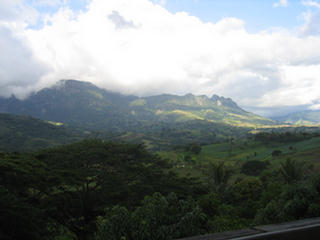 |
Although 221 km from the capital, the
modern international airport at Nadi is the one at which
most of the visitors to the country arrive. There is a
reason for that: Viti Levu’s west coast is much drier
and therefore more appealing to beach-loving tourists.
This coast and the islands scattered to the west are
peppered with resorts, from rustic back-packer camps to
the most luxurious and exclusive retreats, while the
wetter and cloudier east coast and the remote Lau island
group on that side concentrate on the serious business
of sustaining traditional Fijian life.
Although Fiji, Tonga and Samoa have been intertwined in
each others histories throughout the ages, Fiji is
actually considered to be the beginning of a different
cultural and ethnic region known as Melanesia.
Melanesia, Micronesia and Polynesia – the three main
cultural zones of the Pacific islands -- are cultures
that grew out of the eastward movement of an
Austronesian people known as the Lapita. As they pushed
their influence from SE Asia through New Guinea and the
Solomons, they mingled with different peoples which
colored the characteristics of the Melanesian group that
resulted. People are literally darker skinned. Up to
now, everywhere we have been on our voyage – from the
Marquesas to Easter Island to Tonga -- has been
Polynesian, the culture spawned from the Lapita people
that pushed on eastward.
Modern Fiji’s cultural mix is further
complicated by a sizeable Indian population that was
summarily imported at the end of the 19th century to
work as indentured labor on colonial sugar plantations.
Reminiscent of Trinidad, these Indian laborers stayed on
after completing their contracts and, specializing in
commerce and agriculture on leased land, now make up
almost half of the Fijian nation’s population,. But also
much like Trinidad, the two populations often find
themselves in conflict politically, the original
inhabitants on the defensive, fiercely holding onto
their rights and traditions as the indigenous people in
the face of the economic successes of the newer
arrivals. This has resulted in several coups and
uprisings in the past decades that make the tourism
industry nervous. However, tourism has a short memory
and things in Fiji are currently booming.
All this background, a fraction of what we’ve read and
heard, laid a groundwork for our curiosity about this
next leg of our travels. And I would have to say that,
given our affection for the multi-cultural experience of
Trinidad, we were looking forward to seeing how it
worked in Fiji. Despite being happy with our decision to
prolong our stay in Tonga, I know there was a little
disappointment in delaying getting to Fiji. So, we were
looking forward to the sneak preview afforded by our
flight in.
Even so, landing in Nadi and expecting the darker faces
of Fijians, it was a surprise to be surrounded by taxi
drivers and touts for various tours and hotels who were
all clearly Indian! Anyone without a definite
destination upon exiting customs was liable to be
swarmed! Thank goodness for the lead on a place to stay
we’d got at breakfast from one of the guests at The
Villa in Nuku’alofa. We called on a pay phone from the
airport to the reception at Stoney Creek Resort and felt
ourselves lucky to get a “bure” for several nights.
Then, before grabbing a taxi, we rolled our pile of
luggage to the Air New Zealand office to inquire about
moving our flights up. We’d come to realize that we’d
scheduled things rather tightly back in Florida leaving
ourselves less than a week between our return and our
subsequent departure for the annual Christmas round
robin of flights to family in Indiana and South
Carolina. For $100 apiece, we could move our flights up
by four days, a substantial savings compared to the
costs of hotels and meals in Fiji, and buy ourselves a
little more adjustment time in Clearwater.
We might have regretted that change upon arriving at
Stoney Creek.
stoneycreek@connect.com.fj
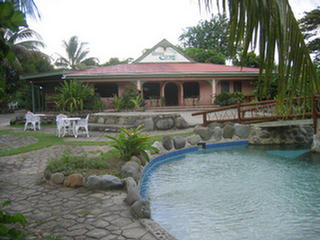 |
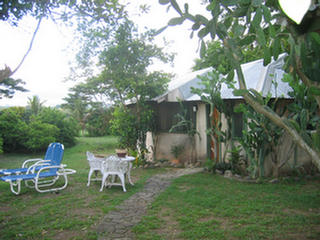 |
This little resort about eight miles from
the airport into sugar cane country sits atop a one of
the foothills of the Sleeping Giant Mountain range. This
affords it a 360 degree view of mountains in one
direction, valley in another and the glittering water of
Nadi bay in a third.
Evolving from the imaginations of its
owners, Gary from New Zealand and Michelle his Fijian
wife, Stoney Creek offers everything from a backpacker’s
dormitory to private rooms to stand-alone bures (cabins)
centered around an elaborate stonework terrace and pool
area. Breakfast and dinner are served to guests daily, a
horse-shoe shaped bar with projection TV caters to a
local weekend clientele for the football (soccer)
matches, and most nights there’s a campfire to sit
around under the stars.
Our bure, if a little on the rustic side
for some, suited us to a T. There was a double bed with
crisp white sheets (that never tucked in!) under a cloud
of mosquito netting, a fridge whose sole purpose was to
keep cold the cream for morning coffee from the coffee
maker, and another tiny bath area where you stepped
through the shower to the toilet.
The staff was definitely eclectic mix.
The main hostess – a tiny girl whose complicated name I
could never get a hold of – was very much Indian. The
other girl we saw most of was Mare, whose nearly black
skin made her shy smile radiate like a beacon. In the
kitchen were girls of Chinese extraction. We were most
entertained by a staff competition to produce “Christmas
Trees” from bare limbs stuck in pots. There was a Fijian
tree, and Indian tree and a Chinese tree!
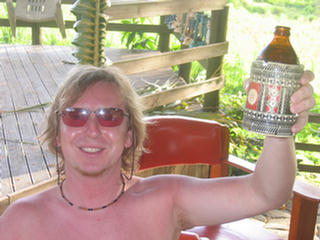 Over
afternoon Fiji Bitters, consumed as we moved from one
vista to the next, ending up with a 360 degree sunset
from the top of the knoll, we made friends with Klaus, a
young German sound engineer who was on his last days of
a month or two he had spent hopping around the Fijian
archipelago. Klaus had signed up for a snorkel trip the
next day out of First Landing Resort, which was right
next to Vuda Point Marina…so we decided to go along, at
the very least as a way to get a look at the marina
facilities. Over
afternoon Fiji Bitters, consumed as we moved from one
vista to the next, ending up with a 360 degree sunset
from the top of the knoll, we made friends with Klaus, a
young German sound engineer who was on his last days of
a month or two he had spent hopping around the Fijian
archipelago. Klaus had signed up for a snorkel trip the
next day out of First Landing Resort, which was right
next to Vuda Point Marina…so we decided to go along, at
the very least as a way to get a look at the marina
facilities.
A van collected us for the day excursion, and we had
only about a half hour to dash over to Vuda Point. Even
though I had seen a diagram of the place, it was still a
surprise to see the perfectly circular marina. The boats
are moored bow and stern in radiating spokes and the
keyhole entrance can, we understand, actually be closed
off in the event of a storm. Surrounding the basin, many
boats were hauled out, most of them in cyclone pits
where the whole boat is lowered into a hole in the
ground lined with tires. The idea, of course, is that in
a storm, they can’t fall down, although I wonder that
the pits don’t fill up with water. We saw several boats
we knew – Bobulona, Sunflower, and the boxy motorsailor
Tom Cat –but Hans of Tom Cat was the only person still
around.
The half-hour, however wasn’t enough to talk with Hans
or the various contractors at the yard, and we had to
rush off to the snorkel boat where everybody was waiting
for us. The snorkel boat wasn’t huge, maybe 28-30’, but
there were four crew and ten passengers, including a
couple with a baby in a stroller! The route was to take
us away from the “mainland” out to the spray of little
sand islands to the west. Each of these islands, it
seems, has a resort of some kind on it. Rustic
backpacker joints and more upscale ones that could have
been anywhere.
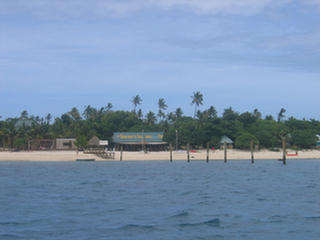 Our
first stop was “Bounty Island” one of the former
category, where we were issued snorkel gear and set
loose on the reef. This actually turned into a nice
little experience for me as, striking out away from the
crowd close in, I saw my first batfish (a pair) and an
octopus. The reef wasn’t world class but mighty nice for
a tourist stop. Our next stop was “Treasure Island”
(catch the motif?!) of the second category, where we
were encouraged to go ashore for lunch…which we had to
buy ourselves from the resort restaurant! Still, it was
a nice chance to socialize with the other tourists. Our
third scheduled stop never happened as the wind and seas
started to kick up. Our
first stop was “Bounty Island” one of the former
category, where we were issued snorkel gear and set
loose on the reef. This actually turned into a nice
little experience for me as, striking out away from the
crowd close in, I saw my first batfish (a pair) and an
octopus. The reef wasn’t world class but mighty nice for
a tourist stop. Our next stop was “Treasure Island”
(catch the motif?!) of the second category, where we
were encouraged to go ashore for lunch…which we had to
buy ourselves from the resort restaurant! Still, it was
a nice chance to socialize with the other tourists. Our
third scheduled stop never happened as the wind and seas
started to kick up.
With our heavy load, the boat seemed to
be wallowing badly in the troughs, and most of the
passengers were starting to turn green. Don, Klaus and I
sat in the stern, better for the bellies, but we got
repeated sluiced with seawater. The refrain of
Gilligan’s Island’s three-hour tour was starting to
chime in our heads! The boat pulled over for a half hour
at Bounty again to let folks settle down (and use the
toilets!), before pushing the rest of the way back. It
seemed to take forever! There were white caps everywhere
driven by the 20-25 winds, and I have to admit it was
somewhat unsettling being in four foot waves that seem
to have sprung up from nothing. Afterwards the crew
insisted that they were going slowly on purpose out of
concern for the baby, but Don and I were not convinced.
Everybody was pretty relieved to get back to shore.
The next day we took a cab back to Vuda Point and spent
the morning talking with the yard workers and the
office, arranging that our unused reservation be
transferred to next year, and wound that up with lunch
with Hans at the Vuda Point “Yacht Club”. Hans is an
interesting character. We first met him and his wife
Ilke in Fatu Hiva, where they squeezed us in at the
European cruiser feast, Hans literally feeding me from
his plate. Germans have such a gruff manner sometimes,
you think they have no use for you, but over the season
we crossed paths with them several times, and it was
clear Hans had taken a liking to us, sharing fish with
us when he caught it, bringing us a gift of sweets when
I loaned him some CDs. Like us they stayed over in
French Polynesia for cyclone season, and we met up with
them again in Raiatea and in Bora Bora where Hans had
his daughter crewing with him. Both Hans and his wife
had health issues they were fighting, and we got the
feeling that Hans, who was lean as a piece of leather,
was hanging on to the adventure as long as he could…not
always with his wife’s indulgence. It looked like this
would be our last crossed path, because Hans was
planning to take Tom Cat onward early the next season,
and we, lingering as we do would fall way behind. The
variety of friendships made cruising, with people who
are not always just like you, is one of the treasures of
the lifestyle.
We flew out from Fiji on the night flight to LA, a long
dark undoing of two years of travel. By changing our
reservations, we had mucked up plans for a spending our
day layover in LA with Michael and Mary of De La Mer,
now back working in LA, so we spent most of the daylight
hours killing time in the airport…which airports are no
longer set up to allow! Only the International Terminal
(which for some reason our flight did not come into) had
restaurants available outside of security. Weary, we
schlepped our hand luggage from one side of LAX to the
other, trying to keep warm (we never remember that LA is
so cool) until finally at five pm we got picked up by
Mary for a quick dinner together after work at a nearby
Italian restaurant.
It’s always a little weird to see cruising friends in
the real world, but it was especially pronounced with
Mary, who makes her living painting murals for the rich
and famous. Formerly a model, Mary had an angular
glamour even as a laid back cruiser like the rest of us,
but decked out for the chic mileu of LA (she’d just come
from working on a bedroom for a famous child actress) it
was almost hard to recognize her! Still we had a good
get together, only sorry that Michael couldn’t get free,
although he had sent us some terrific prints he’d taken
of Tackless and the 2Cs in the Marquesas.
Full of pasta, it was back to LAX for Delta’s red-eye to
Tampa, where we were picked up at 5am by our son-in-law
Derek, who looked like hell. It turned out it was
neither the return of the in-laws or the early hour that
made him look that way. It turned out to be a ruptured
appendix that put him in the hospital several days
later, and changed all our holiday plans.
|